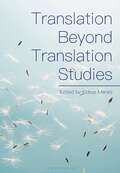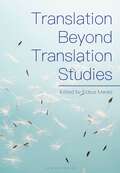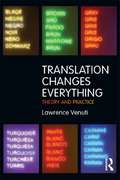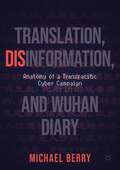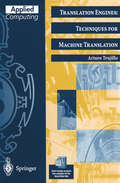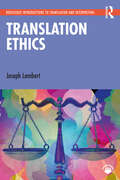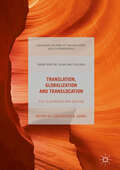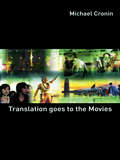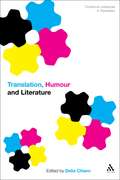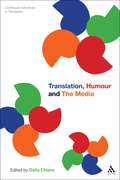- Table View
- List View
Translation Beyond Translation Studies
by Kobus MaraisWhat is 'translation'? Even as the scholarly viewpoint of translation studies has expanded over recent years, the notion of 'translation' has remained fixedly defined by its interlinguistic element. However, there are many different contexts and disciplines in which translation takes place for which this definition is entirely unsuitable.Exploring translational aspects in contexts in which scholars do not think about 'translation', this book considers the alternative uses of the term beyond the interlinguistic dimension. Taking our understanding of 'translation' back to its basic semiotic principles, leading experts outline the wide variety of alternative fields of study, practices, applications and contexts in which the term 'translation' is used. Chapters examine 11 different fields of study, exploring what the term 'translation' means, how it is used and what it could contribute to an enlarged understanding of 'translation' as a concept.In this way, the volume argues for a reimagining of what we mean by translation, providing an essential reference for anyone interested in how translation is understood and practiced beyond the narrow perspectives of the field of translation studies itself.
Translation Beyond Translation Studies
What is 'translation'? Even as the scholarly viewpoint of translation studies has expanded over recent years, the notion of 'translation' has remained fixedly defined by its interlinguistic element. However, there are many different contexts and disciplines in which translation takes place for which this definition is entirely unsuitable.Exploring translational aspects in contexts in which scholars do not think about 'translation', this book considers the alternative uses of the term beyond the interlinguistic dimension. Taking our understanding of 'translation' back to its basic semiotic principles, leading experts outline the wide variety of alternative fields of study, practices, applications and contexts in which the term 'translation' is used. Chapters examine 11 different fields of study, exploring what the term 'translation' means, how it is used and what it could contribute to an enlarged understanding of 'translation' as a concept.In this way, the volume argues for a reimagining of what we mean by translation, providing an essential reference for anyone interested in how translation is understood and practiced beyond the narrow perspectives of the field of translation studies itself.
Translation, Brains and the Computer: A Neurolinguistic Solution to Ambiguity and Complexity in Machine Translation (Machine Translation: Technologies and Applications #2)
by Bernard ScottThis book is about machine translation (MT) and the classic problems associated with this language technology. It examines the causes of these problems and, for linguistic, rule-based systems, attributes the cause to language’s ambiguity and complexity and their interplay in logic-driven processes. For non-linguistic, data-driven systems, the book attributes translation shortcomings to the very lack of linguistics. It then proposes a demonstrable way to relieve these drawbacks in the shape of a working translation model (Logos Model) that has taken its inspiration from key assumptions about psycholinguistic and neurolinguistic function. The book suggests that this brain-based mechanism is effective precisely because it bridges both linguistically driven and data-driven methodologies. It shows how simulation of this cerebral mechanism has freed this one MT model from the all-important, classic problem of complexity when coping with the ambiguities of language. Logos Model accomplishes this by a data-driven process that does not sacrifice linguistic knowledge, but that, like the brain, integrates linguistics within a data-driven process. As a consequence, the book suggests that the brain-like mechanism embedded in this model has the potential to contribute to further advances in machine translation in all its technological instantiations.
Translation Changes Everything: Theory and Practice
by Lawrence VenutiIn Translation Changes Everything leading theorist Lawrence Venuti gathers fourteen of his incisive essays since 2000. The selection sketches the trajectory of his thinking about translation while engaging with the main trends in research and commentary. The issues covered include basic concepts like equivalence, retranslation, and reader reception; sociological topics like the impact of translations in the academy and the global cultural economy; and philosophical problems such as the translator’s unconscious and translation ethics. Every essay presents case studies that include Venuti’s own translation projects, illuminating the connections between theoretical concepts and verbal choices. The texts, drawn from a broad variety of languages, are both humanistic and pragmatic, encompassing such forms as poems and novels, religious and philosophical works, travel guidebooks and advertisements. The discussions all explore practical applications, whether writing, publishing, reviewing, teaching or studying translations. Venuti’s aim is to conceive of translation as an interpretive act with far-reaching social effects, at once enabled and constrained by specific cultural situations. This latest chapter in his developing work is essential reading for translators and students of translation alike.
Translation Changes Everything: Theory and Practice
by Lawrence VenutiIn Translation Changes Everything leading theorist Lawrence Venuti gathers fourteen of his incisive essays since 2000. The selection sketches the trajectory of his thinking about translation while engaging with the main trends in research and commentary. The issues covered include basic concepts like equivalence, retranslation, and reader reception; sociological topics like the impact of translations in the academy and the global cultural economy; and philosophical problems such as the translator’s unconscious and translation ethics. Every essay presents case studies that include Venuti’s own translation projects, illuminating the connections between theoretical concepts and verbal choices. The texts, drawn from a broad variety of languages, are both humanistic and pragmatic, encompassing such forms as poems and novels, religious and philosophical works, travel guidebooks and advertisements. The discussions all explore practical applications, whether writing, publishing, reviewing, teaching or studying translations. Venuti’s aim is to conceive of translation as an interpretive act with far-reaching social effects, at once enabled and constrained by specific cultural situations. This latest chapter in his developing work is essential reading for translators and students of translation alike.
Translation Classics in Context
by Paul F. BandiaTranslation Classics in Context carefully considers the relationship between translation and the classics. It presents readers with revelatory and insightful case studies that investigate translations produced as part of nexuses of colonial resistance and liberation across Africa and in Ireland; translations of novels and folklore collections that influence not just other fictions, but stage productions and entire historical disciplines; struggles over Ukrainian and Russian literature and how it is shaped and transferred; and the role of the academy and the curriculum in creating notions of classic translations.Along the way it covers oral poetry, saints, scholars, Walter Scott and Jules Verne, not to mention Leo Tolstoy and the Corpse Bride making her way from folklore to Frankenstein and into the world of Disney animation. Contributors are all leading scholars, and the book is accessible and engaging, assuming no specialist knowledge.
Translation Classics in Context
Translation Classics in Context carefully considers the relationship between translation and the classics. It presents readers with revelatory and insightful case studies that investigate translations produced as part of nexuses of colonial resistance and liberation across Africa and in Ireland; translations of novels and folklore collections that influence not just other fictions, but stage productions and entire historical disciplines; struggles over Ukrainian and Russian literature and how it is shaped and transferred; and the role of the academy and the curriculum in creating notions of classic translations.Along the way it covers oral poetry, saints, scholars, Walter Scott and Jules Verne, not to mention Leo Tolstoy and the Corpse Bride making her way from folklore to Frankenstein and into the world of Disney animation. Contributors are all leading scholars, and the book is accessible and engaging, assuming no specialist knowledge.
Translation Competence: Theory, Research and Practice (Routledge Advances in Translation and Interpreting Studies)
by Carla QuinciThis book offers a systematic and comprehensive account of translation competence (TC), reflecting on its different models and conceptualisations throughout its development and outlining future directions for both theory and practice. The volume charts the evolution of TC in line with related findings in empirical product- and process-oriented research. In critically examining the different models of translation competence, Quinci explores a wide range of connected issues of ongoing debate within Translation Studies, including translation quality, the revision process, and translator self-assessment. The second section of the book investigates these themes at work in the design, conduct, and results of an award-winning longitudinal research project which analysed the acquisition and development of TC in a sample group of translation trainees and professional translators. The volume builds on the outcomes of this project to offer practical activities for translator education, informed by theory and empirical research, toward encouraging continued reflection and new directions for translation competence research and practice. This book will be of interest to scholars in Translation Studies, as well as translation trainees and active translation professionals.
Translation Competence: Theory, Research and Practice (Routledge Advances in Translation and Interpreting Studies)
by Carla QuinciThis book offers a systematic and comprehensive account of translation competence (TC), reflecting on its different models and conceptualisations throughout its development and outlining future directions for both theory and practice. The volume charts the evolution of TC in line with related findings in empirical product- and process-oriented research. In critically examining the different models of translation competence, Quinci explores a wide range of connected issues of ongoing debate within Translation Studies, including translation quality, the revision process, and translator self-assessment. The second section of the book investigates these themes at work in the design, conduct, and results of an award-winning longitudinal research project which analysed the acquisition and development of TC in a sample group of translation trainees and professional translators. The volume builds on the outcomes of this project to offer practical activities for translator education, informed by theory and empirical research, toward encouraging continued reflection and new directions for translation competence research and practice. This book will be of interest to scholars in Translation Studies, as well as translation trainees and active translation professionals.
Translation Criticism- Potentials and Limitations: Categories and Criteria for Translation Quality Assessment
by Katharina ReissKatharina Reiss's now classic contribution to Translation Studies, Möglichkeiten und Grenzen der Übersetzungskritik: Kategorien und Kriteren für eine sachgerechte Beurteilung von Übersetzungen, first appeared in 1971. This is the first English translation of this major work, allowing students and practitioners of translation in the English-speaking world to make more extensive use of Reiss's pioneering treatment of a central theme in translation: how to develop reliable criteria for the systematic evaluation of translations. Using a wealth of interesting and varied examples, Reiss offers a systematic and illuminating text typology, a pragmatic approach to text analysis, a functional perspective on translation and a hermeneutic view of the translator, thus accounting for some of the most important aspects of the translation process: the text (both source and target versions), the conditions which determine the translator's decisions, and the translator as an individual whose personal interpretation has to be respected by any critic. In the three decades since Katharina Reiss wrote, the terminology of translation studies has evolved on many fronts. Erroll Rhodes' translation strikes an optimal balance between remaining faithful to the original presentation and using terminology that today's reader would generally understand and value.
Translation Criticism- Potentials and Limitations: Categories and Criteria for Translation Quality Assessment
by Katharina ReissKatharina Reiss's now classic contribution to Translation Studies, Möglichkeiten und Grenzen der Übersetzungskritik: Kategorien und Kriteren für eine sachgerechte Beurteilung von Übersetzungen, first appeared in 1971. This is the first English translation of this major work, allowing students and practitioners of translation in the English-speaking world to make more extensive use of Reiss's pioneering treatment of a central theme in translation: how to develop reliable criteria for the systematic evaluation of translations. Using a wealth of interesting and varied examples, Reiss offers a systematic and illuminating text typology, a pragmatic approach to text analysis, a functional perspective on translation and a hermeneutic view of the translator, thus accounting for some of the most important aspects of the translation process: the text (both source and target versions), the conditions which determine the translator's decisions, and the translator as an individual whose personal interpretation has to be respected by any critic. In the three decades since Katharina Reiss wrote, the terminology of translation studies has evolved on many fronts. Erroll Rhodes' translation strikes an optimal balance between remaining faithful to the original presentation and using terminology that today's reader would generally understand and value.
Translation, Disinformation, and Wuhan Diary: Anatomy of a Transpacific Cyber Campaign
by Michael BerryDuring the early days of the COVID-19 health crisis, Fang Fang’s Wuhan Diary provided an important portal for people around the world to understand the outbreak, local response, and how the novel coronavirus was impacting everyday people. But when news of the international publication of Wuhan Diary appeared online in early April of 2020, Fang Fang’s writings became the target of a series of online attacks by “Chinese ultra-nationalists.” Over time, these attacks morphed into one of the most sophisticated and protracted hate Campaigns against a Chinese writer in decades. Meanwhile, as controversy around Wuhan Diary swelled in China, the author was transformed into a global icon, honored by the BBC as one of the most influential women of 2020 and featured in stories by dozens of international news outlets. This book, by the translator of Wuhan Diary into English, alternates between a first-hand account of the translation process and more critical observations on how a diary became a lightning rod for fierce political debate and the target of a sweeping online campaign that many described as a “cyber Cultural Revolution.” Eventually, even Berry would be pulled into the attacks and targeted by thousands of online trolls. This book answers the questions: why would an online lockdown diary elicit such a strong reaction among Chinese netizens? How did the controversy unfold and evolve? Who was behind it? And what can we learn from the “Fang Fang Incident” about contemporary Chinese politics and society? The book will be of interest to students and scholars of translation, as well as anyone with special interest in translation, US-Chinese relations, or internet culture more broadly.
Translation-Driven Corpora: Corpus Resources for Descriptive and Applied Translation Studies (Translation Practices Explained)
by Federico ZanettinElectronic texts and text analysis tools have opened up a wealth of opportunities to higher education and language service providers, but learning to use these resources continues to pose challenges to scholars and professionals alike. Translation-Driven Corpora aims to introduce readers to corpus tools and methods which may be used in translation research and practice. Each chapter focuses on specific aspects of corpus creation and use. An introduction to corpora and overview of applications of corpus linguistics methodologies to translation studies is followed by a discussion of corpus design and acquisition. Different stages and tools involved in corpus compilation and use are outlined, from corpus encoding and annotation to indexing and data retrieval, and the various methods and techniques that allow end users to make sense of corpus data are described. The volume also offers detailed guidelines for the construction and analysis of multilingual corpora. Corpus creation and use are illustrated through practical examples and case studies, with each chapter outlining a set of tasks aimed at guiding researchers, students and translators to practice some of the methods and use some of the resources discussed. These tasks are meant as hands-on activities to be carried out using the materials and links available in an accompanying DVD. Suggested further readings at the end of each chapter are complemented by an extensive bibliography at the end of the volume. Translation-Driven Corpora is designed for use by teachers and students in the classroom or by researchers and professionals for self-learning. It is an invaluable resource for anyone interested in this fast growing area of scholarly and professional activity.
Translation-Driven Corpora: Corpus Resources for Descriptive and Applied Translation Studies (Translation Practices Explained)
by Federico ZanettinElectronic texts and text analysis tools have opened up a wealth of opportunities to higher education and language service providers, but learning to use these resources continues to pose challenges to scholars and professionals alike. Translation-Driven Corpora aims to introduce readers to corpus tools and methods which may be used in translation research and practice. Each chapter focuses on specific aspects of corpus creation and use. An introduction to corpora and overview of applications of corpus linguistics methodologies to translation studies is followed by a discussion of corpus design and acquisition. Different stages and tools involved in corpus compilation and use are outlined, from corpus encoding and annotation to indexing and data retrieval, and the various methods and techniques that allow end users to make sense of corpus data are described. The volume also offers detailed guidelines for the construction and analysis of multilingual corpora. Corpus creation and use are illustrated through practical examples and case studies, with each chapter outlining a set of tasks aimed at guiding researchers, students and translators to practice some of the methods and use some of the resources discussed. These tasks are meant as hands-on activities to be carried out using the materials and links available in an accompanying DVD. Suggested further readings at the end of each chapter are complemented by an extensive bibliography at the end of the volume. Translation-Driven Corpora is designed for use by teachers and students in the classroom or by researchers and professionals for self-learning. It is an invaluable resource for anyone interested in this fast growing area of scholarly and professional activity.
Translation Education: A Tribute to the Establishment of World Interpreter and Translator Training Association (WITTA) (New Frontiers in Translation Studies)
by Junfeng Zhao Defeng Li Lu TianThis book features invited contributions based on the presentations at the First World Interpreter and Translator Training Association (WITTA) Congress, held in Guangzhou, China, in November 2016. Covering a wide range of topics in translation education, it includes papers on the latest developments in the field, theoretical discussions, and the practical implementation of translation courses and programs. Given its scope, the book appeals to translation scholars and practitioners, education policymakers, and language and education service providers.
Translation Engines: Techniques for Machine Translation (Applied Computing)
by Arturo TrujilloMachine translation (MT) is the area of computer science and applied linguistics dealing with the translation of human languages such as English and German. MT on the Internet has become an important tool by providing fast, economical and useful translations. With globalisation and expanding trade, demand for translation is set to grow.Translation Engines covers theoretical and practical aspects of MT, both classic and new, including: - Character sets and formatting languages - Translation memory - Linguistic and computational foundations - Basic computational linguistic techniques - Transfer and interlingua MT - Evaluation Software accompanies the text, providing readers with hands on experience of the main algorithms.
Translation Ethics (Routledge Introductions to Translation and Interpreting)
by Joseph LambertTranslation Ethics introduces the topic of ethics for students, researchers, and professional translators. Based on a successful course and written by an experienced instructor, the Introduction and nine core chapters offer an accessible examination of a wide range of interlocking topic areas, which combine to form a cohesive whole, guiding students through the key debates. Built upon a theoretical background founded in philosophy and moral theory, it outlines the main contributions in the area and traces the development of thought on ethics from absolutism to relativism, or, from staunchly-argued textual viewpoints to current lines of thought placing the translator as agent and an active – even interventionary – mediator. The textbook then examines the place of ethical enquiry in the context of professional translation, critiquing provision such as codes of ethics. Each chapter includes key discussion points, suggested topics for essays, presentations, or in-class debates, and an array of contextualised examples and case studies. Additional resources, including videos, weblinks, online activities, and PowerPoint slide presentations on the Routledge Translation studies portal provide valuable extra pedagogical support. This wide-ranging and accessible textbook has been carefully designed to be key reading for a wide range of courses, including distance-learning courses, from translation and interpreting ethics to translation theory and practice.
Translation Ethics (Routledge Introductions to Translation and Interpreting)
by Joseph LambertTranslation Ethics introduces the topic of ethics for students, researchers, and professional translators. Based on a successful course and written by an experienced instructor, the Introduction and nine core chapters offer an accessible examination of a wide range of interlocking topic areas, which combine to form a cohesive whole, guiding students through the key debates. Built upon a theoretical background founded in philosophy and moral theory, it outlines the main contributions in the area and traces the development of thought on ethics from absolutism to relativism, or, from staunchly-argued textual viewpoints to current lines of thought placing the translator as agent and an active – even interventionary – mediator. The textbook then examines the place of ethical enquiry in the context of professional translation, critiquing provision such as codes of ethics. Each chapter includes key discussion points, suggested topics for essays, presentations, or in-class debates, and an array of contextualised examples and case studies. Additional resources, including videos, weblinks, online activities, and PowerPoint slide presentations on the Routledge Translation studies portal provide valuable extra pedagogical support. This wide-ranging and accessible textbook has been carefully designed to be key reading for a wide range of courses, including distance-learning courses, from translation and interpreting ethics to translation theory and practice.
Translation, Globalization and Translocation: The Classroom and Beyond (Palgrave Studies in Translating and Interpreting)
by Concepción B. GodevThis book examines the spaces where translation and globalization intersect, whether they be classrooms, communities, or cultural texts. It foregrounds the connections between cultural analysis, literary critique, pedagogy and practice, uniting the disparate fields that operate within translation studies. In doing so, it offers fresh perspectives that will encourage the reader to reappraise translation studies as a field, reaffirming the directions that the subject has taken over the last twenty years. Offering a comprehensive analysis of the links between translation and globalization, this ambitious edited collection will appeal to students and scholars who work in any area of translation studies.
Translation goes to the Movies
by Michael CroninThis highly accessible introduction to translation theory, written by a leading author in the field, uses the genre of film to bring the main themes in translation to life. Through analyzing films as diverse as the Marx Brothers’ A Night at the Opera, The Star Wars Trilogies and Lost in Translation, the reader is encouraged to think about both issues and problems of translation as they are played out on the screen and issues of filmic representation through examining the translation dimension of specific films. In highlighting how translation has featured in both mainstream commercial and arthouse films over the years, Cronin shows how translation has been a concern of filmmakers dealing with questions of culture, identity, conflict and representation. This book is a lively and accessible text for translation theory courses and offers a new and largely unexplored approach to topics of identity and representation on screen. Translation Goes to the Movies will be of interest to those on translation studies and film studies courses.
Translation goes to the Movies
by Michael CroninThis highly accessible introduction to translation theory, written by a leading author in the field, uses the genre of film to bring the main themes in translation to life. Through analyzing films as diverse as the Marx Brothers’ A Night at the Opera, The Star Wars Trilogies and Lost in Translation, the reader is encouraged to think about both issues and problems of translation as they are played out on the screen and issues of filmic representation through examining the translation dimension of specific films. In highlighting how translation has featured in both mainstream commercial and arthouse films over the years, Cronin shows how translation has been a concern of filmmakers dealing with questions of culture, identity, conflict and representation. This book is a lively and accessible text for translation theory courses and offers a new and largely unexplored approach to topics of identity and representation on screen. Translation Goes to the Movies will be of interest to those on translation studies and film studies courses.
Translation: A Guide to the Practice of Crafting Target Texts
by Stella Cragie Ann PattisonThis practical guide by two experienced translators and translation tutors explores aspects of time, context and culture in a range of translated literary texts, including novels, memoirs, poems and plays. Reflective analytical sections are complemented by a variety of practical tasks that reflect the book’s craft-based approach. Providing a dual focus on both analysis and creativity, this volume helps readers to develop two different skill sets required for translation: deconstruction and reconstruction. To learn how to analyse or deconstruct a source text (ST), the tasks include translating and editing, comparison and analysis of source language (SL) texts and translations, and critiquing or improving target language (TL) texts produced by translators from different times. A range of creative writing challenges reveal the secrets writers use to hook their readers. Whatever language readers translate into, these insights will help them to find their own writer’s voice, making them better equipped to recreate another author’s voice, whatever the time or cultural context. This is the essential guide to improving target texts for all translators and students of translation.
Translation, Humour and Literature: Translation and Humour Volume 1 (Continuum Advances in Translation)
by Delia ChiaroTranslation studies and humour studies are disciplines that have been long-established but seldom looked at in conjunction. This volume uses literature as the common ground and examines issues of translating humour within a range of different literary traditions. It begins with an analysis of humour and translation in every day life, including jokes and cross-cultural humour, and then moves on to looking at humour and translation in literature through the ages. Despite growing interest and a history of collaborative study, there has been little translation studies scholarship published in this area. This collection features a comprehensive introduction by the editor, which covers strategies and techniques for translating humour as well as the pragmatics involved. The book will appeal to scholars and postgraduates in translation and interpreting studies and humour studies.
Translation, Humour and the Media: Translation and Humour Volume 2 (Continuum Advances in Translation)
by Delia ChiaroTranslation studies and humour studies are disciplines that have been long established but have seldom been looked at in conjunction. This volume looks at the intersection of the two disciplines as found in the media -- on television, in film and in print. From American cable drama to Japanese television this collection shows the range and insight of contemporary cross-disciplinary approaches to humour and translation.Featuring a diverse and global range of contributors, this is a unique addition to existing literature in translation studies and it will appeal to a wide cross-section of scholars and postgraduates.
Translation in a Postcolonial Context: Early Irish Literature in English Translation
by Maria TymoczkoThis ground-breaking analysis of the cultural trajectory of England's first colony constitutes a major contribution to postcolonial studies, offering a template relevant to most cultures emerging from colonialism. At the same time, these Irish case studies become the means of interrogating contemporary theories of translation. Moving authoritatively between literary theory and linguistics, philosophy and cultural studies, anthropology and systems theory, the author provides a model for a much needed integrated approach to translation theory and practice. In the process, the work of a number of important literary translators is scrutinized, including such eminent and disparate figures as Standishn O'Grady, Augusta Gregory and Thomas Kinsella. The interdependence of the Irish translation movement and the work of the great 20th century writers of Ireland - including Yeats and Joyce - becomes clear, expressed for example in the symbiotic relationship that marks their approach to Irish formalism. Translation in a Postcolonial Context is essential reading for anyone interested in translation theory and practice, postcolonial studies, and Irish literature during the 19th and 20th centuries.
